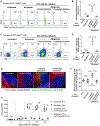Graft-derived extracellular vesicles transported across subcapsular sinus macrophages elicit B cell alloimmunity after transplantation
- PMID: 33731430
- PMCID: PMC8939235
- DOI: 10.1126/scitranslmed.abb0122
Graft-derived extracellular vesicles transported across subcapsular sinus macrophages elicit B cell alloimmunity after transplantation
Abstract
Despite the role of donor-specific antibodies (DSAs) in recognizing major histocompatibility complex (MHC) antigens and mediating transplant rejection, how and where recipient B cells in lymphoid tissues encounter donor MHC antigens remains unclear. Contrary to the dogma, we demonstrated here that migration of donor leukocytes out of skin or heart allografts is not necessary for B or T cell allosensitization in mice. We found that mouse skin and cardiac allografts and human skin grafts release cell-free donor MHC antigens via extracellular vesicles (EVs) that are captured by subcapsular sinus (SCS) macrophages in lymph nodes or analog macrophages in the spleen. Donor EVs were transported across the SCS macrophages, and donor MHC molecules on the EVs were recognized by alloreactive B cells. This triggered B cell activation and DSA production, which were both prevented by SCS macrophage depletion. These results reveal an unexpected role for graft-derived EVs and open venues to interfere with EV biogenesis, trafficking, or function to restrain priming or reactivation of alloreactive B cells.
Copyright © 2021 The Authors, some rights reserved; exclusive licensee American Association for the Advancement of Science. No claim to original U.S. Government Works.
Figures








References
-
- Loupy A, Lefaucheur C, Antibody-mediated rejection of solid-organ allografts. N. Engl. J.Med 379, 1150–1160 (2018). - PubMed
-
- Worthington JE, Martin S, Al-Husseini DM, Dyer PA, Johnson RWG, Posttransplantation production of donor HLA-specific antibodies as a predictor of renal transplant outcome. Transplantation 75, 1034–1040 (2003). - PubMed
-
- Hourmant M, Cesbron-Gautier A, Terasaki PI, Mizutani K, Moreau A, Meurette A, Dantal J, Giral M, Blancho G, Cantarovich D, Karam G, Follea G, Soulillou JP, Bignon JD, Frequency and clinical implications of development of donor-specific and non-donor-specific HLA antibodies after kidney transplantation. J. Am. Soc. Nephrol 16, 2804–2812 (2005). - PubMed
Publication types
MeSH terms
Grants and funding
LinkOut - more resources
Full Text Sources
Other Literature Sources
Medical
Molecular Biology Databases
Research Materials

